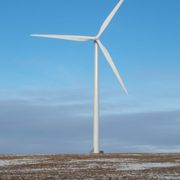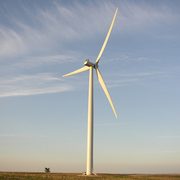-
If you’ve been looking east this morning you may have noticed that Carleton’s wind turbine blades haven’t been doing much turning. While we’d like it to be cranking out clean power the reason for the temporary shut down is impressive indeed. Northfield, in the midst of an uncharacteristic several day long warm front, has also been experiencing some rather blustery winds, above 40 mph at turbine hub height. These gusts have most likely knocked some sensors off balance.
-
Minnesota’s weather often seems to me the creation of a disgruntled, vindictive child. Take, for example, the average wind speeds in the months of December and January. At the time when temperatures begin to really dip, southern Minnesota often experiences some of its highest average wind speeds of the year, so that an otherwise reasonable 5 or 10 degrees F can go to 10 or 15 below in a heartbeat. But while it’s bad news for my face, all that wind is great news for wind turbines.
-
Breaking News! Wind Turbine Breaks 24-Hour Production Record!
On April 15th, 2008, in a reveling display of the tax deductions and other economic benefits of wind power, Carleton’s 1.65 megawatt wind turbine broke its 24-hour production record, propelled by blowing winds of an average of 14.9 meters per second (or 33.3 miles per hour). Between 12:00 AM and 11:59 PM on April 15th, the turbine generated 39,383 kilowatt-hours of renewable energy, practically providing enough electricity to power all of campus. Given that the turbine can only produce 39,600 kilowatt-hours per 24 hours, the turbine was operating at 99.45% efficiency, a level which is practically unheard of in the wind industry. This level production–and these wind speeds–has earned the upper Midwest the title of “the Saudi Arabia of wind.”
-
Our friends over at Williams had their take on this, and I wanted to add a few more points about the differences between Renewable Energy Certificates (RECs) and Offsets.
First of all, RECs and offsets are entirely different environmental commodities. There are many misconceptions about RECs and offsets, and while some will say that it is because vendors have been misleading, I think it is more likely due to the fact that they are both somewhat abstract concepts to consumers and it does require a fair amount of research to be able to understand the differences between them.
A REC, also referred to as a green tag, represensts the environmental benefits of one megawatt-hour of electricity generated by a renewable sources such as wind, solar, or small-scale hydropower. Another commonly cited benefit of RECs is that the money will incentivize the production of renewable energy resource.
As many of our readers probably know, with out turbine, Carleton’s renewable energy credits were sold to Xcel and served as a monetary incentive to construct our wind turbine. Though I was not at Carleton when talks about the turbine were taking place, it is easy to say that the project might not have been financed if Carleton hadn’t been able to sell the credits.
Continue by clicking the “read more” link below
Categories
- Building and Planning
- Carleton's Wind Turbines
- Climate Change
- Conferences
- Cowling Arboretum
- Ecosystem Management
- Emissions and Offsets
- Energy Sources & Uses
- Environmental Justice
- Events
- Food
- Higher Education
- International News
- National News
- News
- STA Program
- Student Life
- Student Projects
- Sustainability
- Sustainable Planning & Development
- Transportation
- Waste

